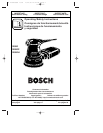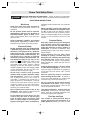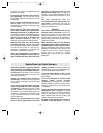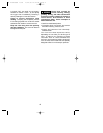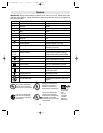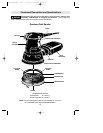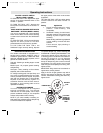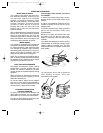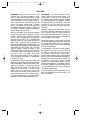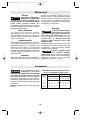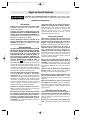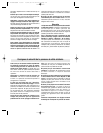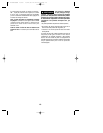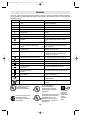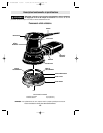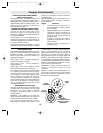
-9-
SANDING: open-coat aluminum oxide
sanding discs are recommended for most
wood or metal sanding applications, as this
synthetic material cuts quickly and wears well.
Some applications, such as plastics, glass, or
stone require silicon carbide discs, which
have a very sharp cutting edge. For best
results, use Bosch sanding and polishing
accessories which are of superior quality and
are carefully selected to produce professional
quality results with your sander.
With the workpiece firmly secured, depress
switch while applying the pad to the work
surface. DO NOT apply excessive pressure
as this will slow the pad action, and DO NOT
start the tool and bring it up to speed before
applying to the work; swirl marks will result in
either case. In general, higher speeds and
moderate pressure will give the best results. If
faster removal is desired, DO NOT INCREASE
PRESSURE ON THE TOOL; use a coarser
grade of abrasive. Move the sander in long
sweeping strokes, parallel to the grain using
some lateral motion to overlap the strokes by
as much as 75%. The random orbit action
allows cross-grain sanding, but be careful not
to tilt the sander near edges, or undesirable
rounding may result.
If the surface is rough, begin with coarser grits
and then complete the surfacing with medium
and fine abrasives. Because the random orbit
action is so effective, it is often possible to
begin sanding with a medium grit disc and go
directly to fine finishing. To avoid uneven
results, do not skip more than one grit size
when going from coarser to finer, and do not
sand in one area for too long. When the job is
completed, release switch, and gently lift the
tool from the work surface at the same time.
POLISHING: for most polishing, the soft
backing pad will give the best results. The
random orbit sander may be fitted with a
foam buffing pad or polishing bonnet to polish
or remove scratches from painted or finished
surfaces, plastics, and even glass. The tool is
operated in much the same way as when
sanding, but the following points should be
observed;
Apply the compound to the surface, and use
the sponge applicator pad with light pressure
and a circular motion to remove scratches
and restore weathered finishes. Use only as
much compound as necessary, and clean the
sponge frequently during use.
When initial polishing is completed, wipe away
any excess compound with a soft towel, and
then polish the surface to its final finish with
the polishing bonnet. Use smooth overlapping
strokes for best results.
It is important to note that the orbit speed of
the random orbit sander is not the same as
the RPM of a standard right-angle polisher.
The random orbit action is much like a
powerful hand polishing action, and therefore
does not have the high speeds at the edge of
the pad which can burn the work surface. For
this reason, it is possible to select a higher
OPM for the random orbit sander than the
recommended RPM for a standard polisher.
Practice on a hidden area or test surface until
you have determined the tool is suitable for
your polishing application.
Clean the buffing pad and polishing bonnet
with mild detergents and warm water. DO
NOT use solvents.
“Tool Tips”
BM 2610968990 11/00 11/14/00 12:26 PM Page 9



